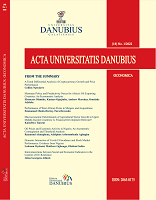The Asymmetric Effects of Interest Rates on Private Investment in South Africa
The Asymmetric Effects of Interest Rates on Private Investment in South Africa
Author(s): Temitope Lydia Adedoyin Leshoro, Paul WabigaSubject(s): Economic policy, Economic development, Financial Markets
Published by: Editura Universitară Danubius
Keywords: Asymmetry; Investment; NARDL; South Africa;
Summary/Abstract: Conventional economic theory states that higher interest rates reduce investment levels because interest rates represent the cost of borrowing, thereby implying a linear inverse relationship. However, the relationship between interest rates and investment is beyond a linear one, which has been previously researched. Thus, the novelty of this study is to investigate the differences between the effects of positive and negative shocks in interest rates on private investment, by examining the asymmetric nature of the relationship between these variables in South Africa. We utilize annual timeseries data from 1971 to 2019 while employing the recent nonlinear autoregressive distributed lag(NARDL) technique. Our study finds that interest rates and private investment exhibit short-run and long-run asymmetric relationships, with private investment responding differently to negative and positive shocks in interest rates. A key conclusion from the study findings is that empirical evidence based on linear analyses of the relationship between interest rates and private investment is insufficient to warrant dependable macroeconomic forecasts. This may lead to misguided policy interventions and management, especially by monetary policy custodians, which ultimately constrains efforts toward sustained economic growth and development.
Journal: Acta Universitatis Danubius. Œconomica
- Issue Year: 19/2023
- Issue No: 3
- Page Range: 161-182
- Page Count: 22
- Language: English

